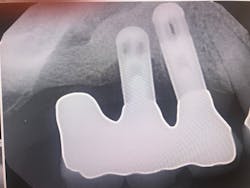How to identify a failing implant: A dental hygienist’s perspective
I have been a dental hygienist for 18 years, 11 of those years in the same prosthodontic office, so I have seen a handful of implants that have failed.
Take a look at Figures 1 and 2. What do both of these radiographs have in common? They both have failed implants.
Success of dental implants depends on the site of the implant placement, the patient’s conditions, surgeons’s experience, the precision of surgical technique and types of implants. Failure of endosseous dental implants may occur prior to occlusal loading with a prosthetic superstructure or later after loading. Based on chronological criteria, the biological failures can be classified into “early failures” (due to unsuccessful osseointergration, indicating impaired bone healing) and “late failures” (due to loss of osseointergration). Several factors may be associated with early implant failure such as smoking, implant characteristics, infection, and insufficient bone quality/quantity. Recognition of risk factors can reduce failure rate and increase the predictability of dental implant treatment.1
Indeed, there are several reasons why an implant can fail. It can be due to a patient’s home care and oral hygiene habits, as the cleanliness of implants and the implant-supported structures must be maintained on a daily basis. It could be a systemic cause, as there are diseases and medications that can cause osteonecrosis of the jaw. Or it could be caused by occlusal trauma. Therefore, a thorough medical history needs to be reviewed at all dental hygiene appointments.
Silverstein and Kurtzman note the following:
Effective oral hygiene around dental implants can be challenging to achieve over the long term, and the patient, dentist and dental hygienist must exercise considerable effort to achieve the desired results. During the maintenance visit, the dental professional should concentrate on the peri-implant tissue margin, implant body, prosthetic abutment-to-implant collar connection and the prosthesis.2
It is vital for the patient to continue with proper home-care techniques, as well as adhering to a supportive maintenance program.
Implant prosthesis design can prevent the patient’s ability to mechanically clean the site with brushes or interdental brush and floss. This is often related to implant positioning and meeting patient expectations for esthetics, phonetics, and function. These concerns should be factored in the decision-making process or treatment plan. It is incumbent for dental providers to teach their patients about the importance of proper plaque control and to encourage them to conduct regular periodontal maintenance.
There are several clinical signs and symptoms of a failing implant. They include severe pain or discomfort at the implant site, a mobile or shifting implant, inflammation of the gingiva around the implant site, difficulty chewing or biting on the implant, and periodontal pocketing around the implant. Also, if a patient is a smoker, this can play a role in implant failure due to the constriction of the blood vessels and change in periodontal tissue.
After having an implant placed, the dental hygienist is the person who patients most frequently see. Informing patients about any risk factors that can jeopardize the success of their dental implants is essential before treatment begins. The dental hygienist also has a primary role not only in implant maintenance but also in patient education. Hygienists need to advise patients about the connection between periodontal disease, peri-implantitis, and other elements that can cause an implant to fail. Patients may be unfamiliar with the proper oral hygiene methods required to keep the implants and oral cavity as clean as possible.
Research has suggested that peri-implantitis can be connected to poor oral hygiene. Gulati et al. state:
Minimizing the incidence of implant loss by regular monitoring of the patient and preventing the recurrence of disease progression in previously treated peri-implantitis patients, along with increasing the probability of locating and treating peri-implant pathology in a timely manner are the main therapeutic goals of maintenance therapy.3
The production of bacterial plaque and biofilm that leads to gingival inflammation will eventually cause peri-implantitis. Therefore, it is necessary to develop a preventative care plan.
Proper monitoring and maintenance is essential to ensure the longevity of the dental implant and its associated restoration through a combination of appropriate professional care, evaluation, and effective patient oral hygiene. The suggested recare appointment for a dental examination and prophylaxis evaluating oral health is three to six months for patients who have implants; however, there are certain factors that can increase a patient’s risk for disease, such as home-care habits, smoking, diabetes, and periodontal disease, as well as certain items in the patient’s medical history that merit an increase in recall frequency.
The procedures that are provided by the dental hygienist should consist of a comprehensive evaluation of biofilm and calculus accumulation, as well as an assessment of intraoral and extraoral tissues. While assessing the implant, two blunt instruments should be used in a buccal-lingual motion (for example, the mouth mirror and the end of a college plier or probe) to check for mobility. The implant should not move. If there is mobility, the implant or implant crown is not secure. It could mean that the crown or abutment could be loose or the implant could be failing. If this happens, then further examination is needed to determine the cause. Erythema, edema, and suppuration, which are the classic symptoms of inflammation, should be recognized if present. Accurate recording of any changes in the soft tissue is very important because change may indicate active disease.
Proper dental instruments and instrumentation should be used during the dental hygiene visit. Metal instruments should not be used around implants because they could scratch the titanium, creating a place for bacteria and plaque to accumulate, and therefore causing harm to the implant or even failure. A plastic probe should be used when probing implants.
There is controversy over whether you should or shouldn’t probe an implant, because it could potentially break the biological seal, but recent research shows that using a probe is acceptable and necessary to get a baseline probing depth and to determine if the implant is healthy or if there is disease present. Gulati et al. note the following:
Probing is an appropriate method to assess potential deleterious changes in the peri-implant environment and should be performed every 3 to 4 months for 1 year after prosthesis delivery. However, to avoid interruption during healing and establishment of the soft tissue seal, it should be avoided during the first 3 months after abutment connection.3
There are specific ultrasonic and piezo tips used to scale implants. Over the tip of each insert, a piece of plastic material is placed that is both removable and disposable. It is there to protect the implant from being harmed during the use of these instruments. They remove calculus, debris, and biofilm from the implant site and lavage the area.
Scalers made of titanium are very useful in removing plaque and calculus on implants. Sometimes plastic tips are screwed into metal handles and used to scale implants as well graphite instruments. These specific instruments ensure that there is no harm or damage to the implants as well as the soft tissue around the implant site. This will help with detecting if the implant is healthy or not.
During a routine dental hygiene visit, it is essential to review home-care instructions with the patient. Patients with implants need to do more than brush and floss for proper oral hygiene maintenance. It is crucial that patients understand how important it is to manage their oral hygiene to prevent any destruction to the implant or implant site.
There is an abundance of oral hygiene aids to assist with implant maintenance at home. The aids that are useful are the Sunstar Gum End-Tuft Brush and Soft-Picks. The Soft-Picks come in Original, Wide, and Advanced; the size of the embrasure space dictates which type you will need. If there is an implant bridge, then Oral-B Super Floss works well to get under the bridge and remove all the particles.
A highly recommended aid to use for all implants is the Waterpik. The Waterpik has several tips that work well to help with maintaining implants. Two very useful tips are the Plaque Seeker and the Pik Pocket. These tips really cleanse the implant area and help with keeping the tissue healthy. Many dental professionals have seen the value and efficacy in improved home care around implants with the use of the Waterpik.
Levin notes the following about implant therapy:
Implant therapy has become common practice and will probably gain popularity during the next several years. This implies that dental professionals will have to deal more with implant failures and complications. When an implant fails, a tailor made treatment plan should be provided to each patient according to all relevant variables. Patients should be informed regarding all possible treatment modalities after implant failure and give their consent to the most appropriate treatment option for them.4
There are various reasons why implants can fail. Our job as dental hygienists is to do a thorough assessment and educate patients on how important it is to maintain their implants. Recommendations for daily home-care regimens, periodic maintenance visits, and regular evaluations are all part of the role of the dental hygienist. Educating patients about any risk factors that can impact the success of their dental implant is crucial.
As a dental hygienist, I want to educate my patients about anything that can lead to dental implant failure. Patients may be unaware of the proper oral hygiene techniques that it takes to keep an implant the oral cavity clean. That is where we as hygienists come in!
References
- Mohajerani H, Roozbayani R, Taherian S, Tabrizi R. The risk factors in early failure of dental implants: a retrospective study. J Dent (Shiraz). 2017;18(4):298-303. https://www.ncbi.nlm.nih.gov/pmc/articles/PMC5702435/. Accessed April 4, 2019.
- Silverstein, Kurtzman. Oral hygiene and maintenance of dental implants. Dentistry Today website. https://www.dentistrytoday.com/implants/341-oral-hygiene-and-maintenance-of-dental-implants#1. Published March 1, 2006. Accessed April 4, 2019.
- Gulati M, Govila V, Anand V, Anand B. Implant maintenance: A clinical update. Int Sch Res Notices. 2014: 908534. doi:10.1155/2014/908534.
- Levin L. Dealing with dental implant failures. J Appl Oral Sci. 2008;16(3):171-175. doi:10.1590/S1678-77572008000300002.









